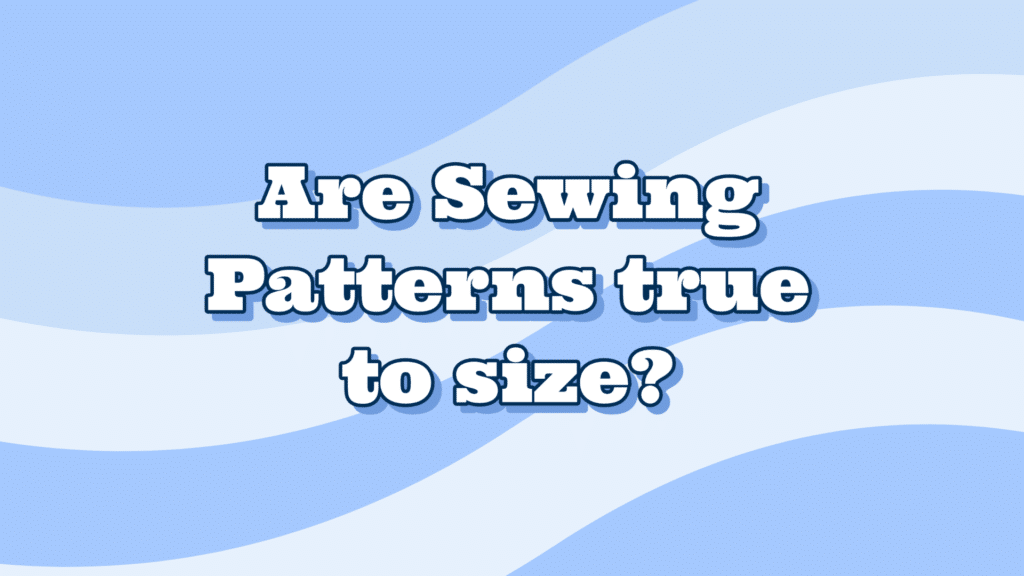When researching or even just talking about sewing patterns you will often come across the question, are sewing patterns true to size? Or equally likely, the common answer that sewing patterns are not true to size at all! In this post I will break down this question a little to see what is going on and why sewing patterns would, or wouldn’t, be true to size.
Traditional Patterns
Traditional commercial patterns are the sewing patterns you will most likely see in hobby stores or the haberdashery section of department stores. They are from big brands and have been around for decades. I don’t want this post to turn into a history lesson, but here is the summary of why ready-to-wear sizes and pattern sizes differ so much.
Firstly, standard sizing was introduced in the 1950s. Women’s average body types now are not the same as they were in the 1950s. In the 70s ready-to-wear sizing adapted to new figures and for many stores, they have continued to adapt their sizing over time. Pattern sizing, however, never seemed to make the same changes. As a result, traditional patterns are unlikely to be true to size. Pattern companies will generally have their own size chart and measurements and they will stick with this across their patterns. This means, even if you are a high-street size 10, you could be a pattern size 16.
Modern Patterns (like Right Side Patterns...)
Sizing is less likely to be an issue in modern sewing patterns from smaller independent brands. Since these brands don’t have any historical size guides, they are more likely to base their sizes off high street stores. However, even high street stores often differ a lot with their sizing.
For Right Side Patterns, we use a combination of high street size guides and data on real peoples bodies. We combine the two for our sizing so that our sizes reflect real people while also being in line with the sizing you are used to in stores.
How do I choose the right pattern size?
When in doubt size up!
This is the number one advice I would give to anyone starting out sewing. Garments can (almost) always be made smaller, but (almost) never be made bigger. If you make a size that is one larger than your usual size it also gives you freedom to mess up a little more. If your sewing isn’t very straight or you get nervous about too small a seam allowance, then you are far better making a pattern that’s slightly big. By the time you finish it, there is a strong possibility that it will be the right size anyway!

How do I make sure it's not too big?
One way to avoid the clothing being too big is trying it on regularly as you pin and sew. Cookbooks will always tell you to taste the food as you cook it and adjust accordingly. Sewing is just like cooking! Let’s say, for example, you are making a skirt. If after sewing one side seam, you pin the other one in place and try it on, you will instantly know if you are about right or way off, when you try it on.
Trying things on as you go along can be a pain, but it is really worth it! Even when patterns are true to size, most people aren’t perfectly one size. The pattern might be a really accurate representation of a size 8 person but lots of people who view themselves as size 8 may be slightly smaller or slightly larger than that size. The great thing about sewing is you can make it fit perfectly. So, try things on as you go, and it will save you a ton of time in the future!
What if I made it already and it's too big?
In that case, it’s about finding the most obvious area to take it in for a better fit. Generally, but not always, this will be the side seams. Continuing with our skirt example, try on the skirt and measure how much extra there is that needs to be taken in. Let’s say its 2 inches. Then take the skirt off, flip it inside out and mark 0.5 inches in on either side. Sew down this line, on both sides, and you will end up making the skirt smaller by an inch on each side which is 2 inches overall. Sometimes, making something smaller is not as easy as this. But look for the most straight forward seam and start there.
So, are sewing patterns true to size?
Well, sometimes.
Important things to remember
- Check the size guide before you assume what size you are.
- Check the seam allowance of the pattern.
- Check whether the company is newer or older as this may impact their sizing
- Finally, if in doubt, size up!
At Right Side Patterns, we try to make our patterns as accurately sized as possible. Each pattern varies so please check the size guide and if you have any questions don’t hesitate to get in touch!

